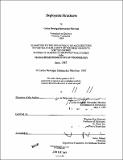| dc.contributor.advisor | Waclaw Piotr Zalewski. | en_US |
| dc.contributor.author | Hernández Merchan, Carlos Henrique | en_US |
| dc.contributor.other | Massachusetts Institute of Technology. Dept. of Architecture. | en_US |
| dc.date.accessioned | 2005-08-08T18:42:12Z | |
| dc.date.available | 2005-08-08T18:42:12Z | |
| dc.date.copyright | 1987 | en_US |
| dc.date.issued | 1987 | en_US |
| dc.identifier.uri | http://hdl.handle.net/1721.1/14970 | |
| dc.description | Thesis (M.S.)--Massachusetts Institute of Technology, Dept. of Architecture, 1987. | en_US |
| dc.description | MICROFICHE COPY AVAILABLE IN ARCHIVES AND ROTCH. | en_US |
| dc.description | Bibliography: leaves 20-21. | en_US |
| dc.description.abstract | This thesis has the purpose of describing the meaning and applications of deployable structures (making emphasis in the scissor-hinged and sliding mechanisms.) and the development of new geometries, details, and mechanisms that make these systems buildable and useful for architectural applications. A deployable structure is one that can be transformed, with the addition of an energy input, from a closed stage or compact configuration to a predetermined, stable expanded form. Deployable structures are suitable in response to the following needs: a- A situation in which there is a need to create enclosed or protected space for a short period of time and then move that space to another location for erection or storage. b- Difficult access places, and/or lack of labor. c- Special applications equipment and shelters for special equipment which can not be transported in full open size and needs to be erected in a very quick way. d- Need to enclose space due to variable weather conditions. e- Situations of high risk with elevated labor costs, hostile environments, costly transportation. f- Construction aid. g- As a construction method There are many mechanisms which fall into the category of deployable structures, but we can group them into two general categories: A) Struts Structures : scissor-hinged, tensile, and sliding mechanisms, etc. B) Surface Structures : folded, inflatable, telescopic, etc. The general characteristic of group A is that these structures are made out of struts which commonly work as compression, tension or bending components connected by joints or hinges. In Group B stresses are carried by surfaces. In some, cases a continuous surface carries only tension forces like, in pressurized or inflatable construction; other structures are made out of small surfaces or planes joined together by some usually flexible means of forming a continuous structure. Deployability implies an extra cost over an assembly structure due to more sophisticated, expensive, movable connections, locking mechanisms, and deployment mechanisms. This extra cost has to be balanced by the structure's greater potential for adaptability, mobility, and labor saving construction. | en_US |
| dc.description.statementofresponsibility | by Carlos Henrique Hernández Merchan. | en_US |
| dc.format.extent | vii, 83 leaves | en_US |
| dc.format.extent | 4273174 bytes | |
| dc.format.extent | 4272936 bytes | |
| dc.format.mimetype | application/pdf | |
| dc.format.mimetype | application/pdf | |
| dc.language.iso | eng | en_US |
| dc.publisher | Massachusetts Institute of Technology | en_US |
| dc.rights | M.I.T. theses are protected by copyright. They may be viewed from this source for any purpose, but reproduction or distribution in any format is prohibited without written permission. See provided URL for inquiries about permission. | en_US |
| dc.rights.uri | http://dspace.mit.edu/handle/1721.1/7582 | |
| dc.subject | Architecture. | en_US |
| dc.title | Deployable structures | en_US |
| dc.type | Thesis | en_US |
| dc.description.degree | M.S. | en_US |
| dc.contributor.department | Massachusetts Institute of Technology. Department of Architecture | |
| dc.identifier.oclc | 16973030 | en_US |
